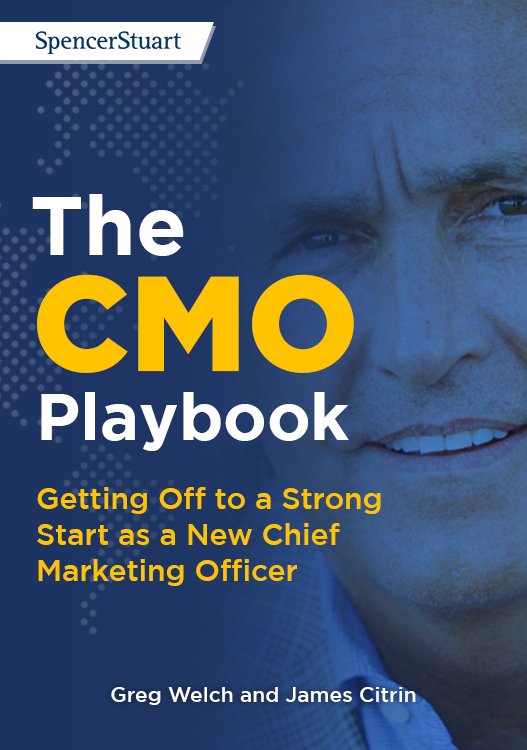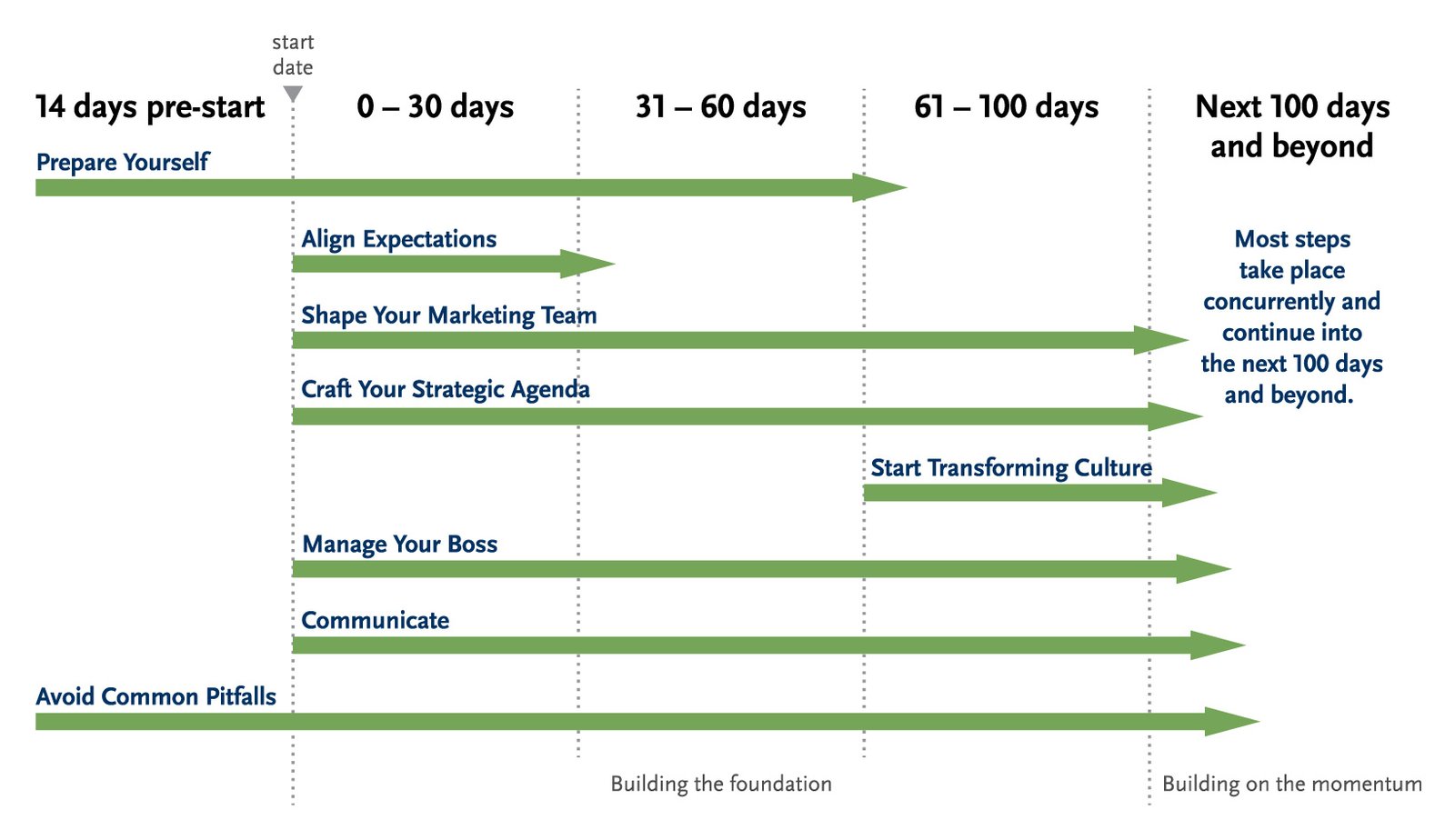
Getting Off to a Strong Start as a New Chief Marketing Officer
Congratulations! During these unpredictable and challenging times, you have landed an exciting new top marketing role. Now what?
At Spencer Stuart, we have studied thousands of executive transitions, and one of our key takeaways is that regardless of whether you are a freshly minted chief executive officer or chief marketing officer, many of the same lessons apply about how to get off to a fast start in your new job. A deliberate and focused transition plan is critical. It can dramatically improve a leader’s ability to build relationships with team members and other stakeholders, develop an effective leadership style, begin shaping a vision for the marketing function, and observe the culture and how work gets done. As you might expect, a thoughtful, well-orchestrated transition plan is even more important in today’s remote- or hybrid-working environments.
We created The CMO Playbook as a resource for the best onboarding advice and pitfalls to avoid for ensuring an impactful transition and early momentum that will set you up for long-term success.


The challenge
It seems like not a week goes by when we don’t hear from a CEO who tells us that he or she “just needs something different” from the company’s CMO. In many cases, this is not actually an indictment of the talent within the function, but a reflection of how the marketing function has and continues to rapidly evolve. The root cause of the CEO’s concerns often stems from the fact that they don’t believe their companies’ approach is fully leveraging “modern” marketing techniques and, in many cases, accelerating digital fast enough. And in a time where the average CMO only lasts for 40 months, it has never been more critical to build momentum early, ensuring your (and importantly your team’s) longer-term success.
The solution
Your first 100 days in a new position is a unique window of opportunity before you become fully entrenched in the demands of the role. Getting off to a fast start (and preparing before day one) can earn your CEO and organization’s confidence and give you the momentum to achieve great long-term performance.

Our 8-point Plan
We have seen many successful marketing leaders follow this tried-and-true 8-point plan:
Prepare yourself during the countdown
- Prepare yourself physically and mentally as your stamina will be tested. A rested mind and body will allow you to rise above the busyness that comes with starting any new job and help you maintain the perspective and mental space to ascertain what is most impactful vs. seemingly urgent.
- Do your homework before you start — whether that is physically in the office or your first Zoom meetings. What are the most important questions that you will need to ask your key constituents?
- Begin your “listening tour” even before you start by speaking with other top management, your boss, other employees (including alumni), your suppliers, analysts, trusted confidantes and other critical stakeholders.
- As many of these initial meetings are likely to occur over video, you will miss out on some of the natural small talk that occurs when meeting in person — offers of coffee, comments about a personal photo or other elements of the surroundings. To put people at ease, consciously take a few minutes at the start of these discussions for a personal warm-up and to demonstrate humanity.
- Recognize what “polishing” any of your skill areas may need — and consider a coach for any specialized training that may help close these gaps. But also know that if you are like many, your own self-assessment may not accurately reflect what the rest of the world sees, so getting an external perspective is useful, including asking for feedback from your interview process. Remember, there is a reason that the world’s best athletes leverage personal coaches. You too could benefit from one.
- Draft your 100-day plan with specific tasks and rough timing so that you have a foundation from which to iterate when you start. Maintain a diary and make note of everything you learn.
- Develop an overt plan to cultivate relationships with your peers in the C-suite. Think about how best to get to know them, building a bridge for the future. Spend quality time with them. Ask questions, be vulnerable and ask for their advice.
- Diagnose some of the value creation opportunities for the business based on what you learned during the interview process. Test drive some of your early hypotheses with a trusted ally, recognizing the perspective that your “fresh eyes” offer during your early days.
- Ask for and review any recent communication or internal documents that can be shared about the company’s strategic vision and history.
Align expectations
- Learn from your boss about what he/she specifically expects you to get done and how success will be measured so that you can effectively cascade that to your team. Make sure you find common ground about these expectations and put them in writing.
- Leaders transitioning in the current climate should push for an explicit conversation with their boss about how the context and priorities for the role have changed due to the crisis. Have there been layoffs? Are people feeling too stretched? Do they have too much time on their hands? Has the crisis made it possible to accelerate planned changes to certain processes or ways of working?
- Think about how you introduce yourself to the team. Be candid about who you are, what motivates and excites you about this opportunity, what they can expect from you and what you hope the team can accomplish together. Spencer Stuart can offer valuable assistance in crafting a well-structured, facilitated team session as a great way to jump start your entrance.
- Continue to share your leadership philosophy to set the tone for your change agenda and align with your team on important norms and behaviors.
- Engage in one-on-one meetings and pose key questions in order to ensure your strategic agenda reflects the institutional knowledge, insights and perspectives of your team. Ask questions like:
- What are the top five most important things to preserve about the company and why?
- What are the top three things we need to change in our marketing approach and function and why?
- What should we change in the department? What about in your specific area?
- What do you most hope I do? If I could change one thing for you, what would be most important?
- What are you most concerned I might do?
- What advice do you have for me?
- How can I help you be more successful?
Shape your marketing team
- Use your one-on-one meetings to quickly determine if you have the expertise required to drive customer experience, consumer insights, CRM, social media, data & analytics, etc.
- Strive for a diverse team, including people from underrepresented groups, that matches the company’s challenges. Remember that diverse teams yield better results!
- Determine what motivates each individual on your team and uncover if they are spending their time in the highest and best use of their abilities. And like the conversation with your boss, align on clear expectations with each team member and put them in writing.
- Think about how to shape the interface with your team. What is the right cadence of meetings? Are there sub teams that you should meet? How often should you have one-on-one meetings and what should they cover? Do NOT just cut and paste the previous CMO’s approach.
- Be aware of how you show up in the virtual world to make sure your messaging and behavior align. Be mindful of your communication style, tone and articulation as people will be less able to read your non-verbal cues on video.
Craft your strategic agenda
- Build your strategic plan as a team. Find the right balance between the compelling picture of where you want to lead the group but leave wiggle room to adapt as you go.
- Diagnose the marketing team’s opportunities by listening to customers. Use this diagnosis to build your short-term strategic agenda, making sure to under-promise and over-deliver.
- Expect some level of pushback on your agenda but, rather than resist, coalesce that input in a positive way to maximize buy-in.
- Ensure that the PURPOSE of your brand and company mission is reflected in everything you and your team do.
- Use your strategic agenda, which is by definition a work in progress, to help you and the organization make decisions, see how they work and adjust as needed.
- Secure some early wins. Look for flaws in the organization and fix them quickly to establish your credibility as a leader and change agent.
- You will need the support of your peers to be successful. Questions that may prove useful with this important group might include:
- How can marketing help the company be more successful?
- How can marketing help your functional area be more successful?
- What are the most important areas where we can collaborate?
- How do you think my experiences or perspective could be most useful to our management team?
Start transforming culture
- Work to understand the culture of the organization, identifying how “things work around here.” Diagnose how significant of a change is required. Look across other functional areas within the culture to see how your marketing team will need to lead or follow others that may be working well.
- Search for the knowledge networks, key influencers, decision-making protocols, and the unwritten and unspoken conventions that are the central nervous system of any organization. Look for clues about how things get done at the company, then listen and learn; within most appearances and generalizations there lies an inner core of truth.
- Solicit views on the culture from a wide of range of people. Then create the conditions within your team for cultural transformation: Adapt measures of success, expectations and operating processes; empower change leaders; and lead by example.
- People are the most receptive to change early in your tenure, so make your first moves count. You may need to make structural and people changes but do so with the bought-in support of the key power center (along with your CEO).
- Establish a concerted program to address the cultural legacies of the organization. Pace yourself, continually assess the tolerance of the organization, get feedback and adapt along the way. Make sure that your boss is fully aware and aligned with your plan.
- Practice what you preach. Leading a strategic agenda and change in a marketing function is not so dissimilar to the marketing objectives you are trying to achieve for external audiences. Deploy the same best practices internally that you would externally to model and reinforce what good looks like.
Manage your boss
- Share your onboarding plan with your boss to ensure alignment with your mutual goals. Given his/her broad mandate, be succinct in your communication about how your plan reinforces your boss’ strategic priorities and how it will drive profitable growth across the enterprise, understanding the stated and unstated motivations.
- Keep your boss aware of each phase of your initial plan. Many skilled CMOs have stumbled early on by not keeping their boss (presumably the CEO) involved during each phase of their initial plan. “Managing your CEO” requires a different approach from what you may have experienced previously.
- Establish your credibility by having a sound strategic agenda, staying on top of the details of the business and implementing an effective communications protocol. Also remember that your boss wants and expects you to have healthy relationships with your peers — particularly if the marketing plan requires a change agenda. One key watch out: your CFO. We have seen many talented CMOs fall out of favor over the years when they lose the support of the CFO due to overspending, lack of financial discipline, or a lack of metrics or data supporting the marketing spend.
- Other points:
- Listen and learn from your boss and establish a discipline of collecting regular feedback.
- Create forums for your boss and your key internal customers to interact with your managers, visit customers and facilities, and dive deeply into key businesses.
Communicate
- Tailor your message and your style to your stakeholders’ readiness and to what they care about. Stakeholders will want to hear your ideas, and it is key that you are consistent and continually reinforce your messages to get your plan embedded with your team.
- Tell poignant stories to establish an emotional connection to your agenda. You have a wonderful platform to talk about the plans for your corporate brand that your fellow employees already care deeply about. Think carefully about how you can ignite excitement in terms of where you hope to take the brand — and why it matters!
- Be conscious of the signals you are sending in the first 100 days. Every move you make is being closely watched — both explicit messages and implicit signals will have an impact.
- Know the communications settings that you are most comfortable in and play to your natural strengths. Use new modern approaches in your communication, intimately intertwined with corporate culture. And, as you might expect, your constituents will expect that you will be creative in your messaging and take advantage of new technologies and forums to share your vision in a compelling way.
- Having all the answers is usually the wrong answer. In your stories, quote other key leaders in the company or offer ideas captured from your customers or consumers. And while this requires significant time investment, it will pay back in enhanced credibility, trust and stakeholder engagement.
- Communication with employees must always be a top priority. You must put yourself in the shoes of those people not as deeply involved as you. They only know a fraction of what you may know.
- Share one fun thing: What will YOUR brand legacy become? As you might expect, when you first arrive, your team (and your peers) will want to know what brought you here and what they can expect from you. You absolutely will need to be prepared to share your “town hall” pitch to share:
- Why you are enthusiastic about the company’s future.
- Personal stories about your upbringing, childhood or experiences. People will want to know that you are real, approachable and entirely human.
- How they should expect you to do your work — what they can expect and what you in turn will expect from them.
- Why you will want their feedback and suggestions and that you intend to listen intently.
- That you will report back with a game plan to help the company win.
Avoid common pitfalls
- Avoid setting unrealistic or unsustainable expectations; in the end, you will be judged by your results. Today’s marketers need to drive profitable growth, but do not be too optimistic in what you can deliver. Change takes time.
- Avoid analysis paralysis. Overly cautious behavior eats up time and models risk-averse behavior to your team.
- Attempt to discern who the most influential leaders are in C-suite. Gauging the true source of power is critical during the early days. Select the right priorities that reflect these sources.
- Don’t succumb to “the savior syndrome” and avoid “dissing” your predecessors. Be respectful and sensitive regarding your predecessor’s position and tenure, regardless of how you feel. And remember the African proverb: “If you want to go fast, go alone. If you want to go far, go together.”
Today’s CMO jobs are big, complex roles, and we rarely see even the best leaders and thinkers ready to tackle them solo. Rely on a supportive peer group, consider hiring a coach and, most importantly, lean on your team. Remember, the leaders with the greatest impact and legacy are those who are able to work through and empower others.
Good for Business: The Rise of the Conscious Corporation
Greg Welch co-authored the acclaimed book Good for Business: The Rise of the Conscious Corporation. He has also been published in Harvard Business Review, Forbes and Advertising Age, Brand Week and he is a frequent guest lecturer in the industry.

In order to satisfy the heightened demands of today’s more powerful consumer, corporations from Wal-Mart to GE are undergoing an evolutionary transformation in the way they do business–from their operations and strategies to their relationships with customers and communities. In this timely book, two top branding experts team up with a highly regarded specialist in corporate culture and a leading global search consultant to illustrate how the most dynamic and promising companies of today are charting a new path for the corporate brand of tomorrow. Good for Business outlines four key elements that will serve as the cornerstones of the most successful businesses of the future:
Purpose Beyond Profit
• Humanized Leadership
• Corporate Consciousness
• Collaborative Partnerships

Today, brands matter a lot, and what companies we do business with also matters. In Good For Business, the authors show not only why building an authentic corporate brand is critical to success, but how to do it in a way that creates more loyal customers, develops a devoted workforce, and makes a social difference in the world at large.
Editorial Reviews
“In the emerging world of extreme transparency, customers and employees will trust companies that are truly making a difference in their lives. Being good will trump looking good. This book clearly outlines winning brand values and the behaviors that lead to that most precious bond: trust.”
“Good for Business blazes a trail for corporate executives who want to succeed in the new economy. The authors offer a big-picture vision about the need for a more holistic and “humanized” view of the corporation, and they provide specific suggestions on how to adapt to a world of empowered consumers, heightened transparency, and changed requirements for leaders. A must read for everyone in the C-suite and all who aspire to get there!”
“With their ‘Four Cornerstones of the Conscious Corporation’ framework, the authors have laid out a clear and compelling vision of a new, more effective way of doing business. Corporate leaders who hope to own the future will heed their advice.”
“Good for Business is an excellent guide that shows how transparency and engagement can positively impact a company’s reputation. Readers can immediately employ the lessons revealed in the book.”
Paid Members of NYDLA: Email the receipt from your book purchase to GoodForBusiness@NYDLA.org and we shall credit your NYDLA membership fee one month (a $25 value). Fill out this form to purchase the book from Amazon.
Powered by: StratusStaff.com

